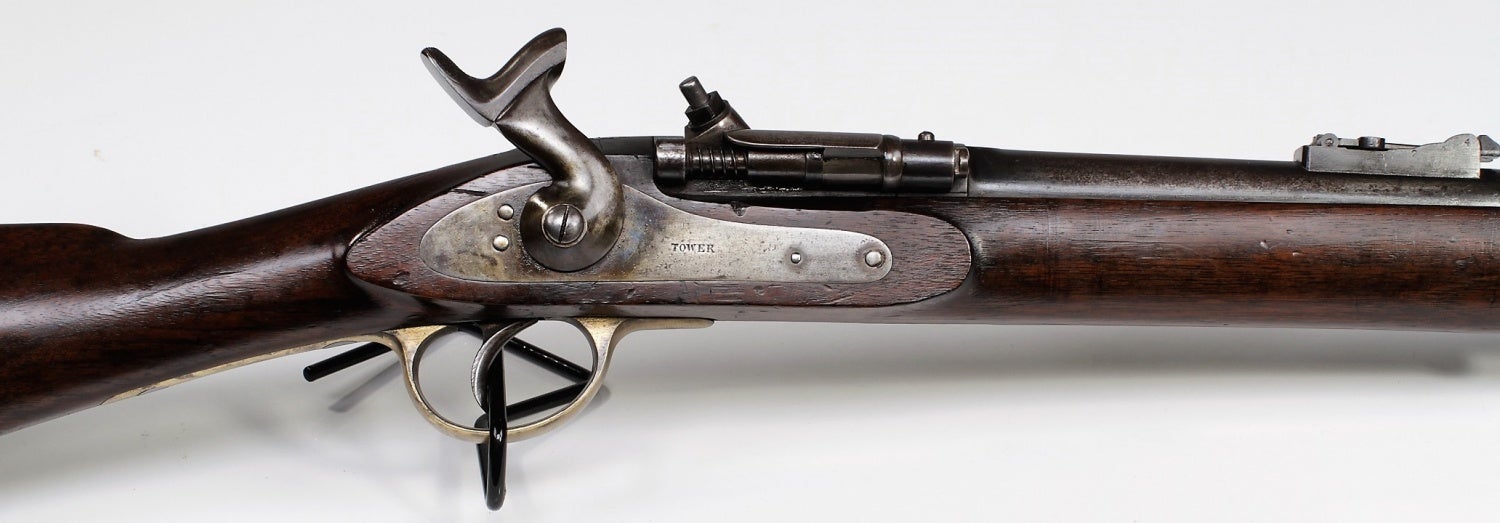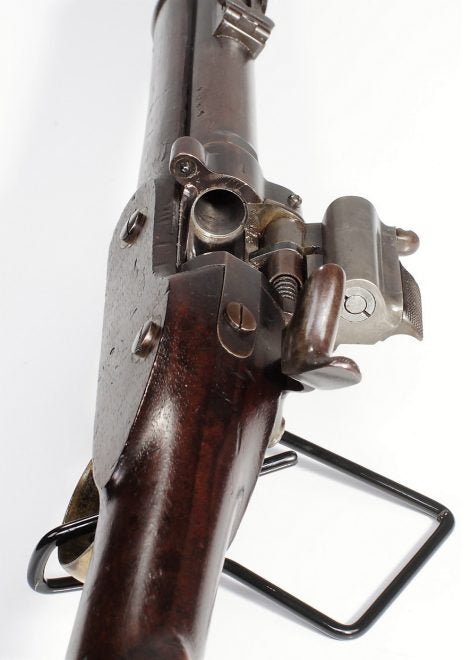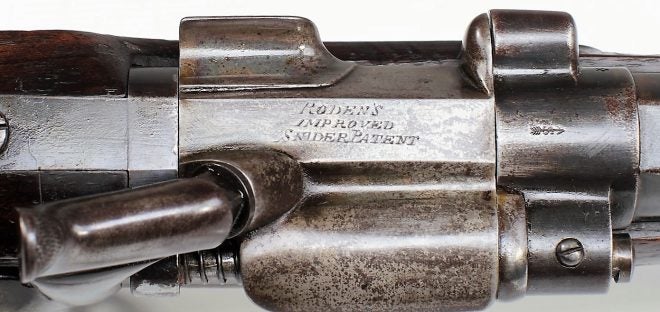1864: The British government adopts (American) Jacob Snider’s breech-loading conversion for the P-1853 musket, with first issue in 1866. It uses a cutting-edge brass cartridge.
1865: The British War Office announces a series of rifle trials to replace the stop-gap Snider.
1866-67: 104 rifles compete until only nine were left standing. None of them exactly won, but the Martini-Henry would eventually emerge.
However, the Snider would stay in service for some time. Over 100,000 rifles and carbines were converted by the end of 1868 when concerns were raised about the breech’s ability to lock securely. The contributions of Mr. Bond and Colonel Dixon are well documented in Skennerton’s A Treatise on the Snider (1978) in which Dixon’s design later became the “Rifle, pattern 1853, Snider (improved action, 1868)” or better known to us today as the Mk III. The following, however, illustrates a third competitor’s prototype: the Roden’s Patent Improved Snider.
Colonel Roden owned half of Jacob Snider’s original patent, and argued with the British government on their behalf. His new mechanism was sound for the time in my opinion. The Colt Patent Fire Arms Mfg. Co. must have felt similarly as their Colt Berdan operated on a similar (if somewhat backwards) principle, and to be fair, the Mk III that won the Ordnance Committee’s improvement board operates similarly still. Let’s take a look.

Roden’s Improved Snider Patent, side view – Institute of Military Technology collection
At the outset, there isn’t much of a noticeable difference between the Roden and the Snider.

Roden’s Improved Snider Patent, action closed – Institute of Military Technology collection
From the rear, very little difference as well with the exception of the retention tab on the top left of the breech that I’ll explain in the next image.

Roden’s Improved Snider Patent, action open – Institute of Military Technology collection
This will begin to look unusual to those familiar with the Snider. The retention plunger/detent at the top left is mostly for administratively holding the breech block closed until something else does – like the hammer. On a Snider the retention plunger it’s at the 6 o’clock position at the rear of the breech block. In the Roden’s case it had to be moved because something else took its place.

Roden’s Improved Snider Patent, partially extracted – Institute of Military Technology collection
A plastic spacer has been inserted to demonstrate the extractor (common to the Snider), but finally from this angle we see the real key. If you’re not familiar with the Snider – or why that big hole in the back of the receiver is important, allow me to demonstrate. (Aficionados will note: this is where we start getting similar to the Mk III)

Roden’s Improved Snider Patent, internal components ‘open’ – Institute of Military Technology collection
Here we see the components inside of the Roden breech block, and we can imagine the hammer back in the cocked position. The action is free to open and close with the exception of the small retention plunger/detent seen previously.

Roden’s Improved Snider Patent, internal components ‘closed’ – Institute of Military Technology collection
Once the hammer falls, the wedge is driven between the locking rod and the firing pin. The firing pin goes forward and strikes the primer, while the locking rod protrudes backward to seal the breech in the recess seen previously. The return spring pressure from each will force the transfer bar back into the recessed ‘open’ position once the hammer is drawn to the rear.
According to John Walter, who recently published in Classic Arms & Militaria magazine there may be two types of Roden improvements. Mr. Walter also cites Skennerton in stating that four Roden improved Sniders participated in the 1866 [Martini-Henry] trials, though at the time of writing this article I have been unable to corroborate as I found no mention of this in Skennerton’s book. Further research is warranted, and will be conducted by the Institute of Military Technology.
Author’s note: Many thanks to Britishmuzzleloaders of YouTube and Facebook fame for his last-minute help with this article.
UPDATE:
Since this article was published we were able to locate the patent. Interestingly, the drawing appears to show one of Snider’s later top-pivot breech conversions:

Roden’s Great Britain patent #3075, Nov. 1st 1867
 Your Privacy Choices
Your Privacy Choices
